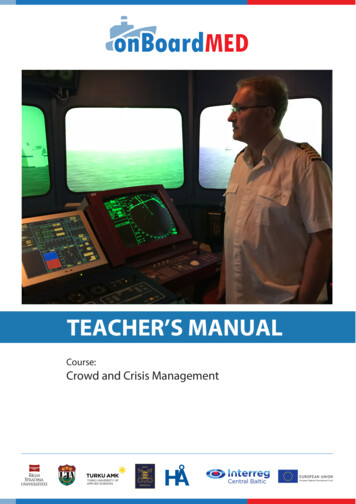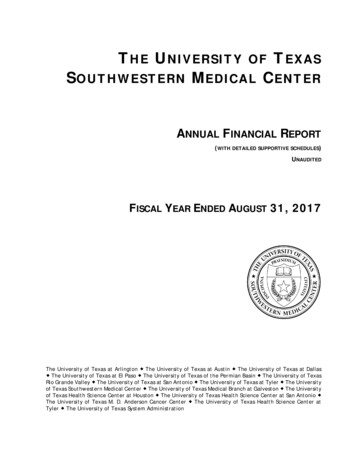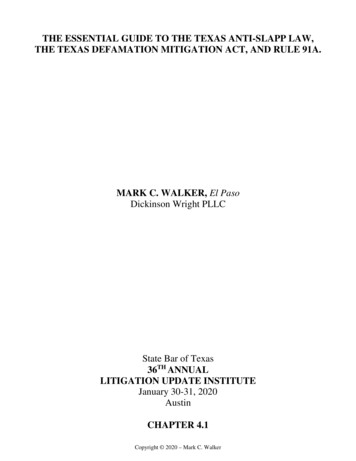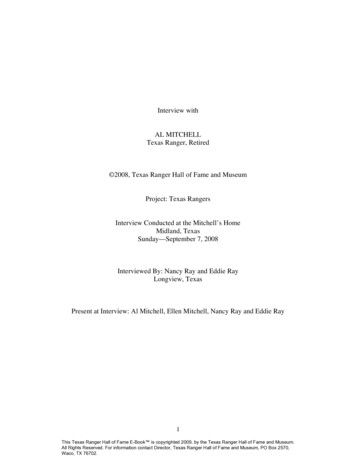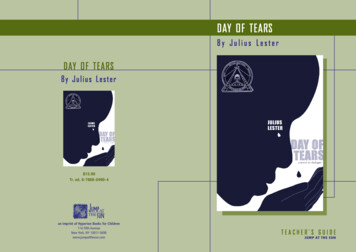![3184 PPT [Read-Only] - Texas Municipal Courts Education Center](/img/38/00-collins-binder-law-update.jpg)
Transcription
5/10/20162015–2017 STATE AND FEDERAL LAW UPDATE84TH LEGISLATIVE SESSIONTCOLE 3184Presented BySgt. Donovon CollinsDART Police DepartmentTraining Coordinator1Texas peace officers are required to complete specifictraining requirements to maintain licensure. Officers holdinga basic proficiency certificate or lower must, in additionto all other training mandates, complete the followingcourses within the 09/01/2013 through 08/31/2017quadrennial training cycle:2 Special Investigative Topics #3232 Cultural Diversity #3939 Crisis Intervention Training #3843: A “cycle” is four years; training mandates are found in TCOLE Rules §218.3 (d)22All Texas peace officers, regardless of certificationlevel, must complete a minimum of 40 hours of inservice training during each biennial training unit. Thistraining must include a TCOLE-approved state andfederal legal update course (TCOLE course 3184 forthe 2015-2017 unit).33:A “unit” is two years; legal update mandate found in TCOLE Rules §218.3 (a)31
5/10/2016A peace officer first licensed on or after January 1, 2011, mustcomplete a basic training program on the trafficking of personswithin one year of licensure.4 Because of the way the enablingstatute is written, the Human Trafficking course that satisfiesthis requirement may not be contained within an officer’s basicpeace officer academy training; it must be taken after theofficer is licensed (i.e., sworn in with a law enforcementagency).4:TCOLE Rules, §218.3 (f )4A new law, HB 593, requires5 peace officers tocomplete a minimum four-hour bloc of training on“canine encounters” within two years of initiallicensure if that training was not a part of the officer’sbasic academy training. Effective January 1, 2016, thecanine encounter training class becomes anintermediate and advanced certification course.5:Occupations Code § 1701.253, School Curriculum5The Commission on Law Enforcement is required by this newstatute to review the canine encounters curriculum at leastonce every four years. The bill does state that an officer whohas previously attended a canine encounter class of at leastfour hours does not need to repeat the class for TCOLEpurposes.62
5/10/2016Another legislatively required change to TCOLE training is from HB 1338, whichamends the Texas Occupations Code. This bill requires6 the Commission on LawEnforcement, in collaboration with the office of acquired brain injury of the Health andHuman Services Commission and the Texas Traumatic Brain Injury Advisory Council,to establish and maintain a training program for peace officers and other firstresponders that provides information on the effects of an acquired brain injury and ofa traumatic brain injury (“TBI”) and techniques to interact with persons who have anacquired brain injury or a traumatic brain injury. Further, HB 1338 requires7 theCommission, in collaboration with the Texas Veterans Commission, to establish andmaintain a training program for peace officers that provides information on veteranswith combat-related trauma, post-traumatic stress, post-traumatic stress disorder, ora traumatic brain injury. An officer is not permitted under this new law to complete thetraining by taking an online course. The Trauma-Affected Veteran training will beincorporated by TCOLE into the Crisis Intervention Training (“CIT”) course.6:7:Occupations Code §1701.261, Acquired and Traumatic Brain Injuries TrainingOccupations Code §1701.262, Trauma Affected Veterans Training7A major change in mandated training for law enforcement supervisorscomes in the form of HB 3211, which completely rewrites the way newsupervisor training must be handled. Previously, newly appointed lawenforcement supervisors were required to complete the TCOLE NewSupervisor Course (#3737) within 24 months after the officer’s firstappointment to a supervisory position. Effective 09/01/2015, HB 3211amends Occupations Code §1701.352(d) to require a peace officerwho is appointed or who will be appointed to the officer's firstsupervisory position to receive in-service training on supervision notearlier than the 12th month before the date of that appointment or laterthan the first anniversary of the date of that appointment. This changepermits LE agencies to train their new leaders before putting them intothe supervisory position.8 HB 2053 adds a course on the use of the Child SafetyCheck Alert List to the classes required for an officer toobtain an intermediate or advanced proficiencycertifcate.8 HB 2684 requires school district peace officers andschool resource officers at school districts with anenrollment of 30,000 students or more to go throughChild Behavior training.9Occupations Code §1701.402, Proficiency CertificatesOccupations Code §1701.263, Education and Training Program for School District PeaceOfficers and School Resource Officers8:9.93
5/10/2016 SB 1987 requires that training on interactions with deafand hard of hearing drivers be completed as part of theBPOC or to obtain an intermediate proficiencycertifcate.10 Senate Bill 1987 also amends theTransportation Code11 to provide for the TexasDepartment of Motor Vehicles' issuance of specialtylicense plates for persons who are deaf or hard ofhearing. A license plate issued under this new law mustinclude an emblem indicating that the person operatingthe vehicle is deaf or hard of hearing.10:11.Occupations Code § 1701.253, School CurriculumTransportation Code §504.204, Persons Who Are Deaf or Hard of Hearing10 Like many of the other TCOLE technical proficiencycertificates, the Investigative Hypnosis ProficiencyCertificate now expires after two years. TCOLE Rule221.7, Investigative Hypnosis Proficiency, requiresholders of the TCOLE Investigative HypnosisProficiency Certificate to complete update training atleast once during each biennial training unit in order tokeep that certificate valid. This rule change went intoeffect on October 17, 2013.11 One of the big changes you will notice is that there havebeen several areas in the Rules that are now numbereddifferently from before. For example, as of November11, 2014, §217.1 (Minimum Standards for Enrollmentand Initial Licensure) has all of the rules for enrollmentin basic training courses and initial licensure in oneplace. Administrators and officers no longer have to lookin one section for peace officers, another for jailers, anda third for tele-communicators.124
5/10/2016 One huge change made by the 84th legislature was designed to address theongoing shortage of qualified applicants for peace officer jobs. Thelegislature recognized that there is a large pool of highly qualified,experienced, former officers whose peace officer licenses have expired butwho would otherwise be excellent applicants. HB 872, effective 09/01/2015,permits12 former Texas peace officers to reactivate their peace officerlicense if the officer:1. completed at least 10 years of full-time service as a peace officer ingood standing before the break in employment;2. meets current licensing standards;A. an online or in-person supplemental peace officer course of not morethan 120 hours;B. other in-person training requirements of not more than 40 hours;3. successfully completes:4. passes a peace officer reactivation examination;5. pays any required fees.12Occupations Code §1701.316, Reactivation of Peace Officer License13NOTE ON OPEN CARRY OF HANDGUNS House Bill 910 is a massive, complicated, 42-page behemoth that madesweeping changes to a huge number of Texas statutes relating to thecarrying and possession of handguns. Previous Texas law provided fora licensing scheme to carry a concealed handgun under certaincircumstances. House Bill 910 amends the Alcoholic Beverage Code,Code of Criminal Procedure, Education Code, Election Code, FamilyCode, Government Code, Health and Safety Code, Labor Code, LocalGovernment Code, Occupations Code, Parks and Wildlife Code, andPenal Code to authorize a person who is licensed to carry a handgunto openly carry a holstered handgun. To add to the confusion, SB 11made changes to gun laws, too.14 You will need to get used to no longer using the term “CHL” forthis type of license, because the weapon no longer has to beconcealed. The statutory term is now simply “HandgunLicense,” so we’re assuming the phrase “HL” will be used fromthis point forward (e.g., “I stopped a guy with an HL and helooked like Dirty Harry with the .44-magnum hog leg he wascarrying in his holster!”).155
5/10/2016TABC code handgun reference Rather than take up pages upon pages of space in this document listingthe changes to signage and rules that these new rules brought intoeffect, keep in mind that (most likely) if it once read “concealedhandgun,” it now most likely simply will read as “handgun.” An example:§11.041(a), Alcoholic Beverage Code, has been changed to read asfollows:(a) Each holder of a permit who is not otherwise required to display a sign underSection 411.204, Government Code, shall display in a prominent place on thepermit holder's premises a sign giving notice that it is unlawful for a person to carrya weapon on the premises unless the weapon is a [concealed] handgun theperson is licensed to carry under Subchapter H, Chapter 411, Government Code.16 One other thing that might help you as you wade through thevoluminous and confusing changes wrought by the changes tothe laws relating to handguns: with a few exceptions, the basicrule is this: if it was illegal to do with a CHL, it’s probably stillillegal to do with an HL in plain view. It was legal to do with aCHL, it’s probably legal to do with a holstered handgun inplain view. That’s obviously over-simplified, but it’s a good rule ofthumb as you work your way through it. Please keep thesechanges in mind as you read through the remainder of thehandout. The open-carry changes are scattered throughout thelaws you will see. You need to read the bills yourself to ensure you’re familiar with them!17 Statutes: §§28.03 (b), (f ), (h) and (j), Criminal Mischief; 28.06(d),Amount of Pecuniary Loss; 8.07 (e), Interference with RailroadProperty; 28.08 (b) and (d), Graffiti; 31.03 (e), Theft; 31.04 (b) and (e);31.08 (c), Value; 31.16 (c) and (d), Organized Retail Theft; 32.02 (c),Value; 32.23 (e), Trademark Counterfeiting; 32.32 (c), False Statementto Obtain Property or Credit or in the Provision of Certain Services;32.33 (d) and (e), Hindering Secured Creditors; 32.34 (f ), FraudulentTransfer of Motor Vehicle; 32.35 (e), Credit Card Transaction RecordLaundering; 32.441 (e), Illegal Recruitment of an Athlete; 32.45 (c),Misapplication of Fiduciary Property or Property of Financial Institution;32.46 (b), Securing Execution of Document by Deception; 33.02 (b-2),Breach of Computer Security; 34.02 (e), Money Laundering; 35.02 (c),Insurance Fraud; 35.025 (b), Value of Claim; 35A.02 (b), MedicaidFraud; and 39.02 (c), Abuse of Official Capacity Effective Date: 09/01/2015186
5/10/2016Legislation: HB 1396For the first time since 1993, we have a new standard value ladder!Standard Value Ladder Effective: 09/01/2015FROMTOLEVEL/DEGREE 99.99M/C 100.00 749.99M/B 750.00 2,499.99M/A 2,500.00 29,999.99SJF 30,000.00 149,999.99F/3 150,000.00 299,999.99 300,000.00F/2F/119Statute: 20.05, Smuggling of PersonsEffective Date: 09/01/2015 Legislation: HB 11There were several changes to §20.05:1. The actor must now have the intent to obtain a pecuniary benefit when heknowingly either:a.b.uses a motor vehicle, aircraft, watercraft, or other means of conveyance to transportsomeone with the intent to conceal that person, fee from law enforcement, etc.; orencourages or induces a person to enter or remain in this country in violation of federallaw by concealing, harboring, or shielding that person from detection.2. The punishment levels have changed, too:a.b.c.F/3 normally;F/2 if the actor commits the offense in a manner that creates a “substantial likelihood” thevictim will suffer SBI or death, or if the victim was 18 YOA at the time of the offense;F/1 if the smuggled individual became a victim of sexual assault, as defined by PC§22.011, or aggravated sexual assault, as defined by PC §22.021; or if the smuggledindividual suffered SBI or death.3. The affirmative defense that was under §20.05(d) is now subsection (c) andmay not be used for the F/2 and F/1 levels of this offense listed above.20NEW Statute: 20.06, Continuous Smuggling ofPersonsEffective Date: 09/01/2015 Legislation: HB 11 A person commits an offense if, during a period that is 10 ormore days in duration, he engages two or more times inconduct that constitutes PC §20.05. You cannot charge someonefor §§20.05 and 20.06 for the same set of actions that constitute theoffense charged. One victim one count, regardless of how manytimes he was smuggled. This offense is punishable as a F/2 unless theact creates substantial likelihood of SBI / death or if the victim isyounger than 18 YOA at the time of offense, in which case F/1. If thesmuggled individual actually became a victim of sexual assault, asdefined by §22.011, or aggravated sexual assault, as defined by§22.021, or if the smuggled individual actually suffered serious bodilyinjury or death, the offense is a F/1 with a minimum punishment of 25years.217
5/10/2016Statute: 20A.03, Continuous Trafficking ofPersonsEffective Date: 09/01/2015 Legislation: HB 10 Section 20.03(a) was rewritten such that it is nowan offense if actor commits trafficking two or moretimes in 30 days "against one or more victims."22NEW Statute: 20A.04, Accomplice Witness;Testimony and ImmunityEffective Date: 09/01/2015 Legislation: HB 10 A party to an offense under chapter 20A can be required toprovide evidence or testify against another about the offense,but may not be prosecuted for any offense about which theparty is required to provide evidence or testify. A convictionunder this chapter may be had on the uncorroboratedtestimony of a party to the offense.23Statute: 21.15, Invasive Visual RecordingEffective Date: IMMEDIATELY Legislation: SB 1317 Senate Bill 1317 amends Penal Code §21.15 to rename the offense ofImproper Photography or Visual Recording as Invasive Visual Recording andto revise the conduct constituting the offense. Specifically, §21.15’s definitionsand the elements of the offense are clarified as follows: A person commits an offense if, without the other person's consentand with intent to invade the privacy of the other person, he:1. photographs or by videotape or other electronic means records, broadcasts, ortransmits a visual image of an intimate area of another person if the other person hasa reasonable expectation that the intimate area is not subject to public view;2. photographs or by videotape or other electronic means records, broadcasts, ortransmits a visual image of another in a bathroom or changing room; or3. knowing the character and content of the photograph, recording, broadcast, ortransmission, promotes a photograph, recording, broadcast, or transmission describedby Subdivision (1) or (2).248
5/10/201621.15 continuedFor purposes of this renamed and reworked offense, (1) "femalebreast" means any portion of the female breast below the top ofthe areola; (2) "intimate area" means the naked or clothedgenitals, pubic area, anus, buttocks, or female breast of aperson; (3) "changing room" means a room or portioned areaprovided for or primarily used for the changing of clothing andincludes dressing rooms, locker rooms, and swimwear changingareas; and (4) “promote" has the meaning assigned by PC§43.21.25NEW Statute: 21.16, VoyeurismEffective Date: 09/01/2015 Legislation: HB 207 House Bill 207 creates the new offense of voyeurism. A personcommits an offense if, with the intent to arouse or gratify sexualdesire of the actor, he observes another without that person'sconsent while the other person is in a dwelling or structure inwhich the other person has a reasonable expectation ofprivacy. This new crime is an M/C unless the actor has twoprior convictions, in which case it becomes an M/B. If the victimis 14 years of age, the offense becomes a SJF. If conduct thatconstitutes an offense under this §21.16 also constitutes anoffense under any other law, the actor may be prosecutedunder this section, the other law, or both.2621.16 continued NOTE: Because of some recent case law out of the TexasCourt of Criminal Appeals related to the constitutionality ofcertain statutory language (“with the intent to arouse or gratifythe sexual desire of the actor”), there is the potential forlitigation on this statute relatively quickly. Also note that someof the same conduct is still covered by the offense ofDisorderly Conduct [PC §42.01(a)(11)] if the actor “windowpeeps” under that law, which is an alternative to this section.Talk with your local prosecutor before making a decision onhow to proceed.279
5/10/2016Statute: 22.021, Aggravated Sexual AssaultEffective Date: 09/01/2015 Legislation: HB 2589 Prosecutors have expressed concern that there is a gap in current lawregarding the age at which a juvenile is considered a disabled individual forpurposes of certain sexual assault offenses. These prosecutors havereported instances in which, because of this age gap, a victim who is not oldenough to be considered a disabled individual for purposes of the moreserious offense of aggravated sexual assault while, at the same time, notyoung enough for purposes of that same offense when the age of the victimis considered—so the offender can only be charged with the less seriousoffense of sexual assault. House Bill 2589 amends the Penal Code to lowerthe age above which a person is considered a disabled individual forpurposes of an aggravated sexual assault offense. "Disabled individual"means a person older than 13 years of age who by reason of age orphysical or mental disease, defect, or injury is substantially unable to protectthe person’s self from harm or to provide food, shelter, or medical care for28the person’s self.Statute: 22.04, Injury to a Child, Elderly Individual,or Disabled IndividualEffective Date: 09/01/2015 Legislation: HB 1286 House Bill 1286 amends the Penal Code to expand theconditions13 that qualify a person as a disabled individual forpurposes of the offense of injury to a child, elderly individual, ordisabled individual. The term “disabled individual” can nowapply regardless of the victim’s age (previously was 14 yearsof age). It is an affirmative defense to prosecution under Subsections(a)(1), (2), and (3) for injury to a disabled individual that theperson did not know and could not reasonably have knownthat the individual was a disabled individual, as defined bySubsection (c), at the time of the offense.2922.04 continued 13 The following were added: autism spectrum disorder, asdefined by §1355.001, Insurance Code; developmentaldisability, as defined by §112.042, Human Resources Code;intellectual disability, as defined by §591.003, Health and SafetyCode; severe emotional disturbance, as defined by §261.001,Family Code; or traumatic brain injury, as defined by §92.001,Health and Safety Code.3010
5/10/2016Statutes: §§25.07, Violation of Certain CourtOrders or Conditions of Bond in a Family Violence,Sexual Assault or Abuse, Stalking, or TraffickingCase and 25.072, Repeated Violation of CertainCourt Orders or Bond in Family Violence, SexualAssault or Abuse, Stalking, or Trafficking CaseEffective Date: 09/01/2015 Legislation: SB 147; HB 2645 See next slide for statute3125.07 continued Senate Bill 147 amends the Code of Criminal Procedure,Government Code, and Penal Code to consolidate provisionsrelating to violations of protective orders or bond conditions in afamily violence, sexual assault or abuse, or stalking case and toinclude trafficking cases14 within the scope of those provisions.The title to §25.072 is changed to include these newparameters. PC §38.112, Violation of Protective Order Issuedon Basis of Sexual Assault or Abuse, Stalking or Trafficking, isrepealed because the conduct prohibited in that section is nowcovered in §§25.07 and 25.072. House Bill 2645 now makes it an offense if a person removes,attempts to remove, or otherwise tampers with the normalfunctioning of a global positioning monitoring system.153225.07 continued 14 For purposes of §25.07, "Trafficking" means any conduct thatconstitutes an offense under §20A.02. 15 "Global positioning monitoring system" has the meaningassigned by Article 17.49, Code of Criminal Procedure.3311
5/10/2016Statute: 30.06, Trespass by License HolderWith a Concealed HandgunEffective Date: 01/01/2016 Legislation: HB 910 In addition to multiple other changes discussed later, HB 910decreases the penalty for a license holder trespassing with aconcealed handgun to a M/C and creates a M/C offensepunishable by a fine not to exceed 200 for a license holdertrespassing with an openly carried handgun. The penalty forthese trespassing offenses is enhanced to a M/A if thetrespasser ignores verbal notice that the person may not enteror remain on the property with a handgun.34Statute: 30.07, Trespass by License Holder Withan Openly Carried HandgunEffective Date: 01/01/2016 Legislation: HB 910 This new section is designed to mirror the elements of §30.06 and applythem to the carriage of openly carried handguns. Importantly, this new lawspecifically clarifies that it is not a defense to prosecution that the pistol iscarried by the actor in a belt holster or shoulder holster. This new law permits property owners to prohibit open carry,concealed carry, or both, from their premises. For purposes of thissection, a person receives notice if the owner of the property or someonewith apparent authority to act for the owner provides notice to the person byoral or written communication. The same signage requirements as §30.06exist (English & Spanish, contrasting colors, 1” block letters, etc.).Importantly, though, the owners must have the applicable (i.e., separate)signage for each type of carriage they wish to prohibit. If they want toprohibit both types, there must be two separate signs. (continued) 3530.07 Continued It is an exception to the application of this new sectionthat the property on which the license holder openlycarries the handgun is owned or leased by agovernmental entity and is not a premises or other placeon which the license holder is prohibited from carryingthe handgun under §§46.03 or 46.035.16 16 Places Weapons Prohibited or Unlawful Carrying of Handgunby License Holder3612
5/10/2016NEW Statute: 31.18, Cargo TheftEffective Date: 09/01/2015 Legislation: SB 1828 For purposes of this new offense, "cargo" means goods, as defined by§7.102, Business & Commerce Code ("all things that are treated asmovable for the purposes of a contract for storage or transportation"),that constitute, wholly or partly, a commercial shipment of freightmoving in commerce. A shipment is considered to be moving incommerce if the shipment is located at any point between the point oforigin and the final point of destination regardless of any temporarystop that is made for the purpose of transshipment or otherwise."Vehicle" has the meaning assigned by TRC §541.201 (basically, anydevice that can be used to transport or draw persons or property on ahighway. The term does not include a device exclusively used onstationary rails or tracks, nor does it include manufactured housing). (continued)3731.18 continued A person commits Cargo Theft if: he knowingly or intentionally conducts, promotes, or facilitates an activityin which the person receives, possesses, conceals, stores, barters,sells, abandons, or disposes of: (A) stolen cargo; or (B) cargo explicitlyrepresented to the person as being stolen cargo; OR is employed as a driver lawfully contracted to transport a specific cargoby vehicle from a known point of origin to a known point of destinationand, with the intent to conduct, promote, or facilitate an activitydescribed above, knowingly or intentionally:A. fails to deliver the entire cargo to the known point of destination ascontracted; orB. causes the seal to be broken on the vehicle or on an intermodalcontainer containing any part of the cargo.(continued)38Punishment is determined by the dollarvalues involved: If value of items stolen is 1,500: this offense doesn'tapply 1,500 - 9,999.99: SJF 10K - 99,999.99: F/3 100K - 199,999.99: F/2 over 200K: F/1 (continued)3913
5/10/201631.18 continuedIf the vehicle is stolen or damaged as part of the samecriminal episode, that value is added into the value of theamount stolen for purposes of punishment. Offensebumps to next higher level (can go no higher than F/1) ifit is shown on the trial of the offense that the person“organized, supervised, financed, or managed” one ormore other persons engaged in an activity describedabove.40Statute: 33.02, Breach of Computer SecurityEffective Date: 09/01/2015 Legislation: HB 896 This bill amends PC §33.02 by adding number (2) toSubsection (b-1) which broadens the concept of the “owner”of a computer to include the government or a business. It alsomakes it an offense for a person to violate a clear andconspicuous prohibition by the owner of the system or toviolate a contractual agreement with the intent to defraud, etc.The bill further adds section (f ) which creates a defense toprosecution if the actor's conduct was due to a contract toprovide security for the computer or other security-relatedservices.41Statute: 33.021, Online Solicitation of a MinorEffective Date: 09/01/2015 Legislation: SB 344 SB 344 alters the elements of the offense needed to establish OnlineSolicitation of a Minor and implying new defenses to prosecution.Section 33.021(a)(1) is amended by removing “represents himself orherself to be” from the definition of “minor.” The definition now includesonly those who actually are younger than 17 years of age or anindividual whom the actor believes to be younger than 17 years of age. Section 33.021 is further changed by amending subsections (b), (d),and (e). Subsection (b) is updated by removing “with the intent toarouse or gratify the sexual desire of any person” and replacing it “withthe intent to commit an offense listed in Article 62.001(5)(A), (B) or (K),CCP.”1742 (continued)14
5/10/201633.021 Continued Continuous Sexual Abuse of Young Child or Children, Indecency witha Child, Sexual Assault, Aggravated Sexual Assault, Prohibited SexualConduct, Compelling Prostitution, Sexual Performance by a Child,Possession or Promotion of Child Pornography, and §20A.02 (a)(3), (4),(7), or (8), Penal Code [Trafficking of Persons].17 Subsection (d) is amended by REMOVING that it is NOT adefense to prosecution that “(2) the actor did not intend for themeeting to occur; or (3) the actor was engaged in a fantasy atthe time of the commission of the offense.” In other words,subsection (d) now says simply that “It is not a defense toprosecution under Subsection (c) that the meeting did notoccur.”43Statute: 36.06, Obstruction or RetaliationEffective Date: 09/01/2015 Legislation: SB 923 In another tool to fight “ doxing,” subsection (a-1) is added to §36.06. This newsubsection states that a person commits an offense if the person posts on apublicly accessible website the residence address or telephone number of anindividual the actor knows is a public servant or a member of a public servant’sfamily or household with the intent to cause harm or a threat of harm to theindividual or a member of the individual’s family or household in retaliation foror on account of the service or status of the individual as a public servant. Thenew offense is a F/3 unless the actor’s conduct is described by Subsection (a1) and results in the bodily injury of a public servant or a member of a publicservant’s family or household, in which case it becomes a F/2. Doxing (from dox, abbreviation of documents), or doxxing,is the Internet‐basedpractice of researching and broadcasting personally identifiable information about anindividual.44Statute: 37.10, Tampering with GovernmentalRecordEffective Date: 09/01/2015 Legislation: HB 644 House Bill 644 adds “a search warrant issued by amagistrate” to the list of items punishable as a F/3 offenseunder section (c)(2).4515
5/10/2016Statute: 38.15, Interference with Public DutiesEffective Date: 09/01/2015 Legislation: HB 1061 Creates a rebuttable presumption of interference with apeace officer if the actor intentionally disseminates thehome address, home telephone number, emergencycontact information, or social security number of theofficer or a family member of the officer. Exempts legitimate radio stations, television stations,and newspapers.46Statute: 39.04, Violations of the Civil Rights ofPerson in Custody; Improper Sexual Activity withPerson in CustodyEffective Date: 09/01/2015 Legislation: SB 183; HB 511 Penal Code §39.04 relates to the violation of civil rights andimproper sexual activity with individuals in custody. SB 183expands subsections (a), (b), and (f ) of that statute to includejuvenile facilities. House Bill 511 amends Code of Criminal Procedure Art. 18.208B(a)(1) and (2) and Penal Code §39.04(e)(1)(B) to includeamong those facilities “any place or facility designated for thedetention of a person suspected of violating a provision of thefederal Immigration and Nationality Act.”47Statute: 43.02, ProstitutionEffective Date: 09/01/2015 Legislation: HB 10; SB 825 HB 10 changes: the F/2 punishment under (c)(3) for thisoffense now includes not only soliciting (A) someoneyounger than 18 YOA, but also someone (B)represented to the actor as being younger than 18years of age; or (C) believed by the actor to beyounger than 18 years of age. continued4816
5/10/201643.02 Continued SB 825 changes: there are often three distinct parties involvedin the crime of prostitution— the pimp, the prostitute, and thepurchaser—but the current statutory framework provides nodistinction between the buyer and seller. Th
A. an online or in-person supplemental peace officer course of not more than 120 hours; B. other in-person training requirements of not more than 40 hours; 3. successfully completes: 4. passes a peace officer reactivation examination; 5. pays any required fees. 12 Occupations Code §1701.316, Reactivation of Peace Officer License 13

